The Cross Point Switch Market is estimated at USD 46.4 billion in 2025 and is projected to reach USD 120.4 billion by 2035, exhibiting a robust CAGR of 10.0%. The market maturity curve and adoption lifecycle reveal distinct phases that define the expansion and consolidation of cross point switch technologies. From the early adoption phase leading up to 2025, growth is driven by initial deployment in high-performance computing, data centers, and telecommunications networks, with technology acceptance concentrated among innovators and early adopters seeking low-latency, high-capacity switching solutions.
Between 2025 and 2030, the market enters a scaling phase, characterized by broader integration across enterprise networking, cloud infrastructure, and emerging 5G applications. During this period, the market value expands from USD 46.4 billion in 2025 to approximately USD 74.7 billion in 2030, reflecting increasing deployment across mid-tier enterprises and standardized implementation of cross point architectures. The adoption rate accelerates due to declining unit costs, improved reliability, and the demonstrable performance advantages of these systems.
From 2030 to 2035, the market transitions into a consolidation phase, where growth continues but at a more measured pace, reaching USD 120.4 billion in 2035. During this stage, the market sees wider penetration across mature segments, and leading technology providers consolidate their positions, while late adopters’ complete integration. The lifecycle demonstrates a progression from niche early adoption through rapid scaling to broad consolidation, with value growth aligned to technological acceptance and cost optimization.
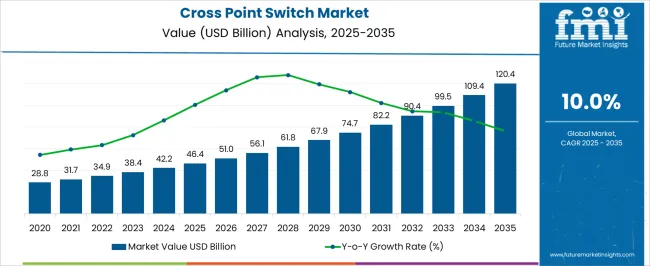
| Metric | Value |
|---|---|
| Cross Point Switch Market Estimated Value in (2025 E) | USD 46.4 billion |
| Cross Point Switch Market Forecast Value in (2035 F) | USD 120.4 billion |
| Forecast CAGR (2025 to 2035) | 10.0% |
The cross point switch market is progressing steadily due to increasing demand for efficient signal routing in telecommunications and data networking applications. Advances in digital switching technology have significantly improved data throughput and reduced latency, making digital cross point switches a preferred choice.
As network architectures grow more complex and require scalable solutions, the need for larger form factors such as 64*64 and above has increased. These larger configurations accommodate the rising number of data channels in modern communication systems.
The shift toward software-defined networking and flexible data routing has driven growth in single-layer cross point switches that offer simplicity and reliability. Increasing investments in cloud infrastructure, data centers, and 5G deployments are expected to further expand market opportunities. The digital type, larger form factors, and single-layer switches are poised to lead market growth due to their adaptability and performance in high-demand environments.
The cross point switch market is segmented by type, digital and analog; by form factor, ≥64x64, 12x12 to <64x64, 2x2 to <12x12, and others; by functionality, single-layer and multi-layer cross point switches; by technology, CMOS and MEMS; by end use, consumer electronics, aerospace and defense, automotive, industrial, and others; by region, North America, Europe, Asia-Pacific, Latin America, and Middle East & Africa.
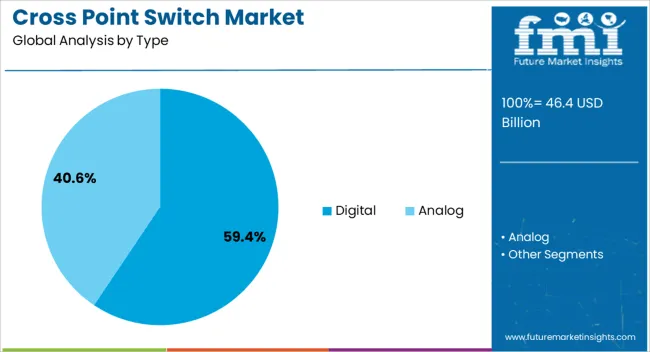
The digital cross point switch segment is projected to hold 59.4% of the market revenue in 2025, retaining dominance as the most widely used type. Digital switches offer precise control over signal routing and superior signal integrity compared to analog alternatives.
Their ability to support high-speed data transfer and integration with modern communication protocols has made them essential in telecom and networking equipment. As demand for faster and more reliable data services grows, digital cross point switches are increasingly preferred by system designers seeking scalable and programmable switching solutions.
Continuous improvements in digital switch technology are also enhancing energy efficiency and reducing operational complexity, reinforcing this segment’s market leadership.
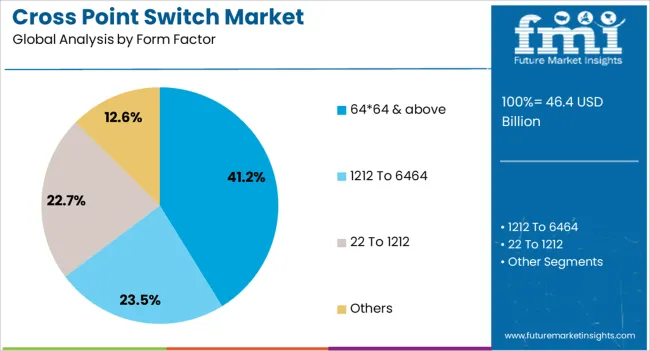
The 6464 and above form factor segment is expected to account for 41.2% of the cross point switch market revenue in 2025, reflecting the need for high-density switching matrices. Larger form factors are necessary to handle the increased volume of data channels and connections in contemporary network infrastructures.
These configurations are particularly valuable in data centers, telecommunication hubs, and enterprise networking where scalability and flexibility are paramount. The trend towards network virtualization and increased bandwidth demands has encouraged the adoption of larger switch matrices that can accommodate complex routing needs without adding excessive hardware.
As networks continue to scale, the demand for 6464 and higher form factors is anticipated to grow steadily.
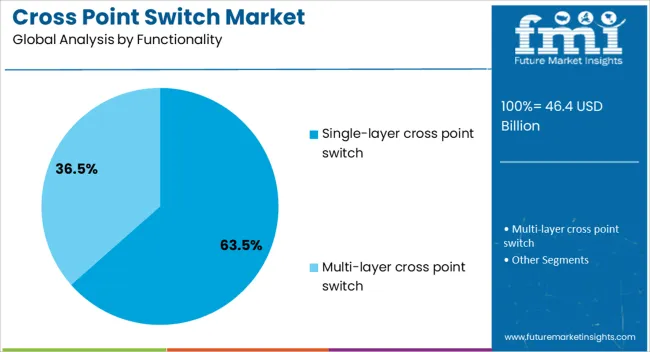
The single-layer cross point switch segment is projected to contribute 63.5% of the market revenue in 2025, establishing itself as the dominant functionality type. Single-layer switches offer a simplified architecture that reduces signal latency and power consumption compared to multi-layer designs.
Their straightforward design enhances reliability and ease of maintenance, factors that are crucial in mission-critical communication systems. The adoption of single-layer switches has been driven by their effectiveness in applications requiring fast switching speeds and minimal signal degradation.
Furthermore, advancements in manufacturing processes have made single-layer cross point switches more cost-effective and easier to integrate into diverse network environments. Given these advantages single-layer switches are expected to sustain their leading position in the market.
The market has been expanding due to the growing demand for high-speed, reliable signal routing in telecommunication networks, data centers, broadcast systems, and industrial applications. Cross point switches have been widely deployed to enable simultaneous connections between multiple inputs and outputs while maintaining signal integrity. Market growth has been supported by advancements in optical and electronic switching technologies, low-latency designs, and integration with high-bandwidth networks. Increasing digitalization, network modernization, and rising data traffic have further strengthened the adoption of cross point switches globally.
The need for high-speed, low-latency data routing has been a major driver of the cross point switch market. These switches allow multiple inputs and outputs to be interconnected simultaneously, supporting seamless signal transmission across telecommunication networks, broadcast systems, and data centers. Increasing network traffic, driven by cloud computing, 5G deployment, and high-definition content delivery, has intensified the requirement for reliable switching infrastructure. Electronic and optical cross point switches provide low insertion loss, high isolation, and rapid switching capabilities, ensuring minimal signal degradation. The growing adoption of software-defined networks (SDN) and network function virtualization (NFV) has increased demand for programmable and scalable cross point switches. These trends have made cross point switches critical for maintaining network efficiency, reliability, and performance.
Technological innovations have significantly improved the performance, scalability, and reliability of cross point switches. Optical switches with MEMS-based designs, high-speed electronic switches, and hybrid configurations have enabled higher bandwidth, reduced crosstalk, and enhanced switching speed. Integration with digital signal processing, programmable logic, and intelligent control systems has allowed dynamic routing, error detection, and network optimization. Low-power designs and compact architectures have reduced operational costs and footprint in data centers and telecommunication hubs. Multi-layer switch fabrics and modular configurations have facilitated scalability for expanding networks and complex routing requirements. These advancements have strengthened the deployment of cross point switches across high-speed communication networks, broadcasting facilities, and industrial automation systems globally.
Compliance with international standards, industry protocols, and performance regulations has influenced the adoption of cross point switches. Telecommunication and data center operators have required switches that meet electromagnetic compatibility, signal integrity, and reliability standards. Standardized interfaces and protocol compatibility with Ethernet, optical transport networks, and high-speed data protocols have ensured seamless integration. The environmental and energy efficiency regulations have prompted manufacturers to develop low-power, eco-friendly switch solutions. Compliance with safety, operational, and network reliability requirements has reinforced market confidence, particularly in mission-critical applications. Regulatory adherence, combined with performance expectations for high-capacity and low-latency data transmission, has driven the widespread adoption of cross point switches across global networking and industrial sectors.
The expansion of 5G networks, cloud computing infrastructure, and hyperscale data centers has created significant growth opportunities in the cross point switch market. High-bandwidth traffic, virtualization, and real-time data processing have increased demand for fast, low-latency switching solutions. Optical and electronic cross point switches have been deployed to manage complex signal routing in telecommunication hubs, server farms, and broadcast facilities. The trend toward intelligent, software-defined network architectures has created opportunities for programmable and remotely managed switch fabrics. As digital transformation, video streaming, and IoT adoption continue to accelerate, the need for robust, scalable, and energy-efficient cross point switches is expected to rise, positioning the market for long-term growth globally.
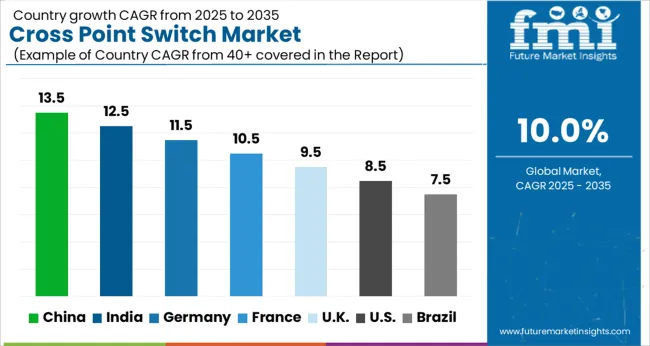
The market is projected to expand at a CAGR of 10.0% between 2025 and 2035, fueled by rising demand for high-speed data routing, network optimization, and advanced telecommunication infrastructure. China is expected to lead with a 13.5% CAGR, supported by large-scale deployment of 5G networks and data center expansion. India follows at 12.5%, driven by increasing internet penetration and modernization of telecom infrastructure. Germany, at 11.5%, benefits from robust networking ecosystems and enterprise adoption. The UK, with a 9.5% CAGR, emphasizes upgrading existing network infrastructures, while the USA, at 8.5%, experiences growth through advanced data center and cloud networking initiatives. This report includes insights on 40+ countries; the top markets are shown here for reference.
The industry in China is projected to expand at a CAGR of 13.5% from 2025 to 2035, driven by the growing need for high-speed signal routing and data center interconnectivity. Local manufacturers are focusing on low-latency and high-bandwidth solutions to support cloud computing and telecommunication infrastructure. Adoption is particularly strong in enterprise networking and hyperscale data centers where efficient signal distribution is critical. Domestic OEMs are investing in advanced switch fabrics and scalable architectures to meet rising demands. Government-backed technology initiatives and private investments are further accelerating deployment of high-performance switching solutions across telecom and data-intensive industries.
The Indian market for cross point switches is expected to grow at a CAGR of 12.5% between 2025 and 2035, supported by expansion of IT infrastructure and adoption of cloud and telecom services. Enterprises are integrating high-performance switches to manage data center traffic and improve bandwidth efficiency. Local manufacturers are developing modular and scalable switch designs to meet sector-specific requirements. Increasing investments in network modernization and private data centers are driving uptake. Telecommunications and financial sectors are adopting cross point switch technology to ensure reliable and secure data transmission, enhancing overall operational efficiency.
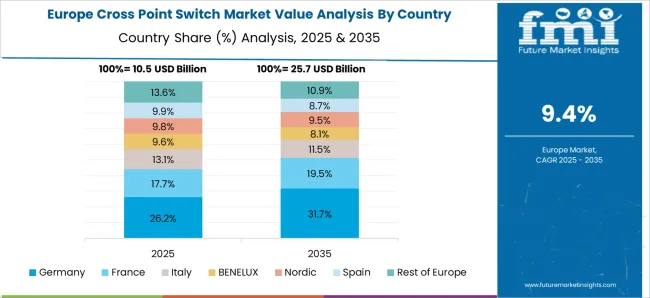
The market in Germany is projected to expand at a CAGR of 11.5% from 2025 to 2035, fueled by the need for high-speed interconnectivity in industrial automation and enterprise networking. Local players are emphasizing energy-efficient designs and low-latency switching solutions. Adoption is concentrated in smart factories, data centers, and telecom infrastructure upgrades. Integration of switches with AI-driven monitoring systems is enabling predictive network maintenance and bandwidth optimization. European standards and regulatory compliance for high-performance networking drive investments in reliable cross point switch solutions.
The United Kingdom cross point switch industry is forecast to grow at a CAGR of 9.5% from 2025 to 2035, supported by expansion of high-speed networking in corporate and public sector data centers. Companies are adopting modular switch architectures for flexible traffic management and improved network reliability. Telecom operators are upgrading backbone infrastructure with high-performance switches to meet growing demand for cloud-based services. Enterprise adoption is increasing in finance, IT, and media sectors. Investments in edge computing and low-latency applications are accelerating the integration of cross point switching solutions.

The United States market for cross point switches is projected to grow at a CAGR of 8.5% from 2025 to 2035, driven by rising demand for high-speed data routing in cloud computing, enterprise networks, and telecommunication infrastructure. Adoption of modular and high-capacity switch solutions supports hyperscale data center operations and financial sector network reliability. Integration with AI-enabled monitoring and automated traffic management systems is improving performance and uptime. Federal initiatives supporting digital infrastructure modernization further boost the deployment of cross point switches across industries requiring efficient signal distribution and data handling.
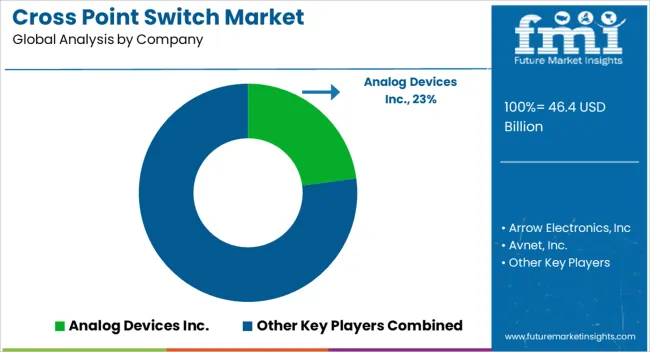
Analog Devices Inc. is a prominent player offering high-performance cross point switches that support low latency and high signal integrity, catering to complex signal routing needs in telecom and data infrastructure.
Arrow Electronics, Inc. focuses on distribution and integrated solutions, enabling seamless deployment of cross point switch technology across multiple industries. Avnet, Inc. combines supply chain expertise with technical support to facilitate rapid adoption of cross point solutions. Intersil Corporation delivers cross point switches with robust performance for high-frequency applications, ensuring minimal signal distortion and reliability under demanding operating conditions.
Lattice Semiconductor Corporation emphasizes programmable cross point switch solutions, allowing customization for specific application requirements in embedded systems and communications. LSI Corporation provides high-capacity cross point switches optimized for storage networks, server interconnects, and enterprise data solutions. MACOM Technology Solutions focuses on analog and RF cross point switches for high-speed optical networks and next-generation communication systems.
Market strategies include product launches targeting higher bandwidth capabilities, R&D for low-power and compact designs, and strategic partnerships with OEMs for integrated solutions. Entry barriers include high development costs, complex signal integrity requirements, and competition from established global players, making technical innovation and reliability key differentiators for success.
| Item | Value |
|---|---|
| Quantitative Units | USD Billion |
| Type | Digital and Analog |
| Form Factor | 64*64 & above, 1212 To 6464, 22 To 1212, and Others |
| Functionality | Single-layer cross point switch and Multi-layer cross point switch |
| Technology | Complementary Metal-Oxide-Semiconductors (CMOS) and Micro-Electro-Mechanical Systems (MEMS) |
| End Use | Consumer electronics, Aerospace & defense, Automotive, Industrial, and Others |
| Regions Covered | North America, Europe, Asia-Pacific, Latin America, Middle East & Africa |
| Country Covered | United States, Canada, Germany, France, United Kingdom, China, Japan, India, Brazil, South Africa |
| Key Companies Profiled | Analog Devices, Inc., Arrow Electronics, Inc., Avnet, Inc., Renesas Electronics Corporation (formerly Intersil Corporation), Lattice Semiconductor Corporation, Broadcom Inc. (formerly LSI Corporation), MACOM Technology Solutions Inc. |
| Additional Attributes | Dollar sales by switch type and application sector, demand dynamics across telecommunications, data centers, and broadcast systems, regional trends in adoption across North America, Europe, and Asia-Pacific, innovation in high-speed switching, low-latency architectures, and modular design, environmental impact of energy consumption, heat dissipation, and electronic waste, and emerging use cases in 5G network infrastructure, high-frequency trading systems, and automated signal routing for multimedia applications. |
The global cross point switch market is estimated to be valued at USD 46.4 billion in 2025.
The market size for the cross point switch market is projected to reach USD 120.4 billion by 2035.
The cross point switch market is expected to grow at a 10.0% CAGR between 2025 and 2035.
The key product types in cross point switch market are digital and analog.
In terms of form factor, 64*64 & above segment to command 41.2% share in the cross point switch market in 2025.






Our Research Products

The "Full Research Suite" delivers actionable market intel, deep dives on markets or technologies, so clients act faster, cut risk, and unlock growth.

The Leaderboard benchmarks and ranks top vendors, classifying them as Established Leaders, Leading Challengers, or Disruptors & Challengers.

Locates where complements amplify value and substitutes erode it, forecasting net impact by horizon

We deliver granular, decision-grade intel: market sizing, 5-year forecasts, pricing, adoption, usage, revenue, and operational KPIs—plus competitor tracking, regulation, and value chains—across 60 countries broadly.

Spot the shifts before they hit your P&L. We track inflection points, adoption curves, pricing moves, and ecosystem plays to show where demand is heading, why it is changing, and what to do next across high-growth markets and disruptive tech

Real-time reads of user behavior. We track shifting priorities, perceptions of today’s and next-gen services, and provider experience, then pace how fast tech moves from trial to adoption, blending buyer, consumer, and channel inputs with social signals (#WhySwitch, #UX).

Partner with our analyst team to build a custom report designed around your business priorities. From analysing market trends to assessing competitors or crafting bespoke datasets, we tailor insights to your needs.
Supplier Intelligence
Discovery & Profiling
Capacity & Footprint
Performance & Risk
Compliance & Governance
Commercial Readiness
Who Supplies Whom
Scorecards & Shortlists
Playbooks & Docs
Category Intelligence
Definition & Scope
Demand & Use Cases
Cost Drivers
Market Structure
Supply Chain Map
Trade & Policy
Operating Norms
Deliverables
Buyer Intelligence
Account Basics
Spend & Scope
Procurement Model
Vendor Requirements
Terms & Policies
Entry Strategy
Pain Points & Triggers
Outputs
Pricing Analysis
Benchmarks
Trends
Should-Cost
Indexation
Landed Cost
Commercial Terms
Deliverables
Brand Analysis
Positioning & Value Prop
Share & Presence
Customer Evidence
Go-to-Market
Digital & Reputation
Compliance & Trust
KPIs & Gaps
Outputs
Full Research Suite comprises of:
Market outlook & trends analysis
Interviews & case studies
Strategic recommendations
Vendor profiles & capabilities analysis
5-year forecasts
8 regions and 60+ country-level data splits
Market segment data splits
12 months of continuous data updates
DELIVERED AS:
PDF EXCEL ONLINE
Cross-chain NFT Market Size and Share Forecast Outlook 2025 to 2035
Switchgear for Data Centers Market Size and Share Forecast Outlook 2025 to 2035
Cross-species Organ Transplantation Market Forecast and Outlook 2025 to 2035
Cross Interconnection Protection Box Market Size and Share Forecast Outlook 2025 to 2035
Cross Corner Industrial Bags Market Size and Share Forecast Outlook 2025 to 2035
Cross-Linked Polyethylene Market Size and Share Forecast Outlook 2025 to 2035
Switchrack Assemblies Market Size and Share Forecast Outlook 2025 to 2035
Point-of-Care Fentanyl Test Kits Market Size and Share Forecast Outlook 2025 to 2035
Point-of-Care Opioid Testing Market Size and Share Forecast Outlook 2025 to 2035
Point-of-Care Food Sensitivity Testing Market Size and Share Forecast Outlook 2025 to 2035
Point-of-Care Diagnostics Market Size and Share Forecast Outlook 2025 to 2035
Cross-Border Road Transport Market Size and Share Forecast Outlook 2025 to 2035
Switching Residential Voltage Regulator Market Size and Share Forecast Outlook 2025 to 2035
Switching Commercial Voltage Regulator Market Size and Share Forecast Outlook 2025 to 2035
Crossfit Apparel Market Size and Share Forecast Outlook 2025 to 2035
Point-Of-Care Breathalyzer Market Size and Share Forecast Outlook 2025 to 2035
Cross Pein Hammer Market Size and Share Forecast Outlook 2025 to 2035
Cross Training Shoes Market Size and Share Forecast Outlook 2025 to 2035
Point Of Care Blood Testing Devices Market Size and Share Forecast Outlook 2025 to 2035
Point-of-care Cholesterol Monitoring Device Market Size and Share Forecast Outlook 2025 to 2035

Thank you!
You will receive an email from our Business Development Manager. Please be sure to check your SPAM/JUNK folder too.
Chat With
MaRIA